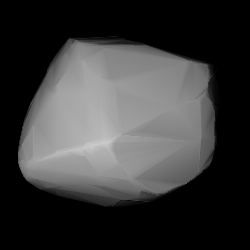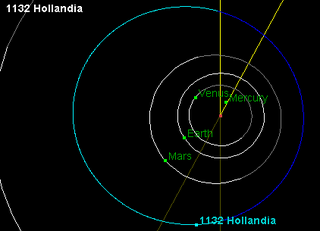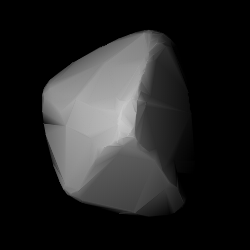Related Research Articles

1039 Sonneberga, provisional designation 1924 TL, is a dark background asteroid, approximately 34 kilometers in diameter, located in the central region of the asteroid belt. It was discovered on 24 November 1924, by German astronomer Max Wolf at Heidelberg Observatory in southwest Germany. The asteroid was named for the German city of Sonneberg, where the Sonneberg Observatory is located.

1054 Forsytia is a dark background asteroid, approximately 46 kilometers in diameter, from the outer regions of the asteroid belt. It was discovered on 20 November 1925, by astronomer Karl Reinmuth at the Heidelberg-Königstuhl State Observatory in southwest Germany and assigned provisional designation 1925 WD. It is named after the flowering plant forsythia, and marks the beginning of a sequence of 28 thematically named asteroids by the discoverer.
1070 Tunica, provisional designation 1926 RB, is a dark background asteroid from the outer regions of the asteroid belt, approximately 35 kilometers in diameter. It was discovered on 1 September 1926, by German astronomer Karl Reinmuth at the Heidelberg-Königstuhl State Observatory in southwest Germany. The asteroid was named after Petrorhagia, a flowering plant also known as "Tunica".
1076 Viola, provisional designation 1926 TE, is a Nysian asteroid from the inner regions of the asteroid belt, approximately 22 kilometers in diameter. It was discovered on 5 October 1926, by German astronomer Karl Reinmuth at the Heidelberg Observatory in southwest Germany. The asteroid was named after the flowering plant Viola.

1080 Orchis, provisional designation 1927 QB, is an dark background asteroid from the inner regions of the asteroid belt. It was discovered on 30 August 1927, by German astronomer Karl Reinmuth at the Heidelberg Observatory in southwest Germany. The carbonaceous F-type asteroid has a rotation period of 16.1 hours and measures approximately 22 kilometers in diameter. It was named after the flowering plant Orchis.

1081 Reseda is a dark background asteroid from the outer regions of the asteroid belt. It was discovered on 31 August 1927, by astronomer Karl Reinmuth at the Heidelberg-Königstuhl State Observatory in southwest Germany. The asteroid has a rotation period of 7.3 hours and measures approximately 37 kilometers in diameter. It was named after the herbaceous plant Reseda.

1082 Pirola is a dark Themistian asteroid from the outer regions of the asteroid belt. It was discovered on 28 October 1927, by German astronomer Karl Reinmuth at the Heidelberg-Königstuhl State Observatory in Germany, and assigned the provisional designation 1927 UC. The carbonaceous C-type asteroid has a rotation period of 15.9 hours and measures approximately 41 kilometers in diameter. It was named after the herbaceous plant Pyrola (wintergreen).
1085 Amaryllis, provisional designation 1927 QH, is a background asteroid from the outer regions of the asteroid belt, approximately 69 kilometers in diameter. It was discovered on 31 August 1927, by astronomer Karl Reinmuth at the Heidelberg-Königstuhl State Observatory in southwest Germany. The asteroid was named after the flowering plant Amaryllis.
1091 Spiraea, provisional designation 1928 DT, is a carbonaceous Cybele asteroid from the outer regions of the asteroid belt, approximately 36 kilometers in diameter. It was discovered on 26 February 1928, by astronomer Karl Reinmuth at the Heidelberg-Königstuhl State Observatory in southwest Germany. The asteroid was named after Spiraea, a genus of plants.
1106 Cydonia, provisional designation 1929 CW, is a Eunomian asteroid from the central regions of the asteroid belt, approximately 13 kilometers in diameter. It was discovered on 5 February 1929, by astronomer Karl Reinmuth at the Heidelberg-Königstuhl State Observatory in Germany. The asteroid was named for the fruit-bearing tree Cydonia (quince). The S-type asteroid has a relatively short rotation period of 2.7 hours.

1132 Hollandia, provisional designation 1929 RB1, is a stony asteroid from the middle region of the asteroid belt, approximately 27 kilometers in diameter. It was discovered on 13 September 1929, by Dutch astronomer Hendrik van Gent at Leiden Southern Station, annex to the Johannesburg Observatory in South Africa. It was named for the region Holland in the Netherlands.
(9928) 1981 WE9, provisional designation 1981 WE9, is a stony Florian asteroid from the inner regions of the asteroid belt, approximately 3 kilometers in diameter. It was discovered on 16 November 1981, by astronomers at Perth Observatory in Bickley, Australia.
11277 Ballard (provisional designation 1988 TW2) is a Phocaea asteroid from the inner regions of the asteroid belt, approximately 6.3 kilometers (3.9 miles) in diameter. It was discovered on 8 October 1988, by American astronomer couple Carolyn and Eugene Shoemaker at the Palomar Observatory in California. The assumed S-type asteroid has a rotation period of at least 10 hours. It was named for American marine scientist Robert Ballard.
1232 Cortusa, provisional designation 1931 TF2, is a background asteroid from the outer regions of the asteroid belt, approximately 40 kilometers (25 miles) in diameter. It was discovered on 10 October 1931, by astronomer Karl Reinmuth at the Heidelberg Observatory in southwest Germany. The X-type asteroid has a rotation period of 25.2 hours. It was named after the plant Cortusa and indirectly honors astronomer Gustav Stracke.
1250 Galanthus, provisional designation 1933 BD, is a dark background asteroid from the central regions of the asteroid belt, approximately 20 kilometers in diameter. It was discovered on 25 January 1933, by German astronomer Karl Reinmuth at the Heidelberg Observatory. The asteroid was named for the herbaceous plant Galanthus, also known as "snowdrop".
1267 Geertruida, provisional designation 1930 HD, is a carbonaceous background asteroid from the inner regions of the asteroid belt, approximately 20 kilometers in diameter. Discovered by astronomer Hendrik van Gent at Johannesburg Observatory in 1930, the asteroid was later named after Geertruid Pels, sister of Dutch astronomer Gerrit Pels.
1233 Kobresia, provisional designation 1931 TG2, is a carbonaceous background asteroid from the central regions of the asteroid belt, approximately 33 kilometers in diameter. It was discovered on 10 October 1931, by German astronomer Karl Reinmuth at the Heidelberg Observatory in southwest Germany. The asteroid was named for the grass-like flowering plant Kobresia, a genus in the sedge family.
1383 Limburgia, provisional designation 1934 RV, is a carbonaceous asteroid from the outer region of the asteroid belt, approximately 23 kilometers in diameter. It was discovered on 9 September 1934, by Dutch astronomer Hendrik van Gent at the Leiden Southern Station, annex to the Johannesburg Observatory in South Africa. It is named for the Dutch province Limburg.
1303 Luthera, provisional designation 1928 FP, is a dark asteroid and the parent body of the Luthera family, located in the outermost regions of the asteroid belt. It measures approximately 90 kilometers in diameter. The asteroid was discovered on 16 March 1928, by astronomer Friedrich Schwassmann at the Bergedorf Observatory in Hamburg, Germany, and later named after German astronomer Robert Luther.

2120 Tyumenia is a dark background asteroid, approximately 45 kilometers in diameter, located in the outer regions of the asteroid belt. It was discovered on 9 September 1967, by Soviet astronomer Tamara Smirnova at the Crimean Astrophysical Observatory in Nauchnyj, on the Crimean peninsula. The asteroid was named for the now Russian district of Tyumen Oblast in Western Siberia.
References
- 1 2 3 4 5 6 "JPL Small-Body Database Browser: 1092 Lilium (1924 PN)" (2017-03-29 last obs.). Jet Propulsion Laboratory . Retrieved 25 September 2017.
- ↑ "lilium" . Oxford English Dictionary (Online ed.). Oxford University Press.(Subscription or participating institution membership required.)
- 1 2 3 Schmadel, Lutz D. (2007). "(1092) Lilium". Dictionary of Minor Planet Names – (1092) Lilium. Springer Berlin Heidelberg. p. 93. doi:10.1007/978-3-540-29925-7_1093. ISBN 978-3-540-00238-3.
- 1 2 3 4 5 "LCDB Data for (1092) Lilium". Asteroid Lightcurve Database (LCDB). Retrieved 25 September 2017.
- 1 2 "Asteroid 1092 Lilium – Proper Elements". AstDyS-2, Asteroids – Dynamic Site. Retrieved 28 October 2019.
- 1 2 3 4 Nugent, C. R.; Mainzer, A.; Bauer, J.; Cutri, R. M.; Kramer, E. A.; Grav, T.; et al. (September 2016). "NEOWISE Reactivation Mission Year Two: Asteroid Diameters and Albedos". The Astronomical Journal. 152 (3): 12. arXiv: 1606.08923 . Bibcode:2016AJ....152...63N. doi: 10.3847/0004-6256/152/3/63 .
- 1 2 Masiero, Joseph R.; Grav, T.; Mainzer, A. K.; Nugent, C. R.; Bauer, J. M.; Stevenson, R.; et al. (August 2014). "Main-belt Asteroids with WISE/NEOWISE: Near-infrared Albedos". The Astrophysical Journal. 791 (2): 11. arXiv: 1406.6645 . Bibcode:2014ApJ...791..121M. doi:10.1088/0004-637X/791/2/121. S2CID 119293330 . Retrieved 25 September 2017.
- 1 2 3 4 Mainzer, A.; Grav, T.; Masiero, J.; Hand, E.; Bauer, J.; Tholen, D.; et al. (November 2011). "NEOWISE Studies of Spectrophotometrically Classified Asteroids: Preliminary Results". The Astrophysical Journal. 741 (2): 25. arXiv: 1109.6407 . Bibcode:2011ApJ...741...90M. doi:10.1088/0004-637X/741/2/90.
- 1 2 3 4 Masiero, Joseph R.; Mainzer, A. K.; Grav, T.; Bauer, J. M.; Cutri, R. M.; Nugent, C.; et al. (November 2012). "Preliminary Analysis of WISE/NEOWISE 3-Band Cryogenic and Post-cryogenic Observations of Main Belt Asteroids". The Astrophysical Journal Letters. 759 (1): 5. arXiv: 1209.5794 . Bibcode:2012ApJ...759L...8M. doi:10.1088/2041-8205/759/1/L8. S2CID 46350317 . Retrieved 25 September 2017.
- 1 2 3 4 Tedesco, E. F.; Noah, P. V.; Noah, M.; Price, S. D. (October 2004). "IRAS Minor Planet Survey V6.0". NASA Planetary Data System. 12: IRAS-A-FPA-3-RDR-IMPS-V6.0. Bibcode:2004PDSS...12.....T . Retrieved 22 October 2019.
- 1 2 3 4 Nugent, C. R.; Mainzer, A.; Masiero, J.; Bauer, J.; Cutri, R. M.; Grav, T.; et al. (December 2015). "NEOWISE Reactivation Mission Year One: Preliminary Asteroid Diameters and Albedos". The Astrophysical Journal. 814 (2): 13. arXiv: 1509.02522 . Bibcode:2015ApJ...814..117N. doi:10.1088/0004-637X/814/2/117. S2CID 9341381 . Retrieved 25 September 2017.
- 1 2 3 4 Usui, Fumihiko; Kuroda, Daisuke; Müller, Thomas G.; Hasegawa, Sunao; Ishiguro, Masateru; Ootsubo, Takafumi; et al. (October 2011). "Asteroid Catalog Using Akari: AKARI/IRC Mid-Infrared Asteroid Survey". Publications of the Astronomical Society of Japan. 63 (5): 1117–1138. Bibcode:2011PASJ...63.1117U. doi:10.1093/pasj/63.5.1117. (online, AcuA catalog p. 153)
- 1 2 3 Binzel, R. P. (October 1987). "A photoelectric survey of 130 asteroids". Icarus. 72 (1): 135–208. Bibcode:1987Icar...72..135B. doi:10.1016/0019-1035(87)90125-4. ISSN 0019-1035 . Retrieved 25 September 2017.
- 1 2 Warner, Brian D. (September 2008). "Asteroid Lightcurve Analysis at the Palmer Divide Observatory: December 2007 - March 2008". The Minor Planet Bulletin. 35 (3): 95–98. Bibcode:2008MPBu...35...95W. ISSN 1052-8091 . Retrieved 25 September 2017.
- ↑ Veres, Peter; Jedicke, Robert; Fitzsimmons, Alan; Denneau, Larry; Granvik, Mikael; Bolin, Bryce; et al. (November 2015). "Absolute magnitudes and slope parameters for 250,000 asteroids observed by Pan-STARRS PS1 - Preliminary results". Icarus. 261: 34–47. arXiv: 1506.00762 . Bibcode:2015Icar..261...34V. doi:10.1016/j.icarus.2015.08.007. S2CID 53493339 . Retrieved 25 September 2017.
- 1 2 "1092 Lilium (1924 PN)". Minor Planet Center. Retrieved 25 September 2017.
- ↑ Schmadel, Lutz D. (2007). "(1054) Forsytia". Dictionary of Minor Planet Names – (1054) Forsytia. Springer Berlin Heidelberg. p. 90. doi:10.1007/978-3-540-29925-7_1055. ISBN 978-3-540-00238-3.